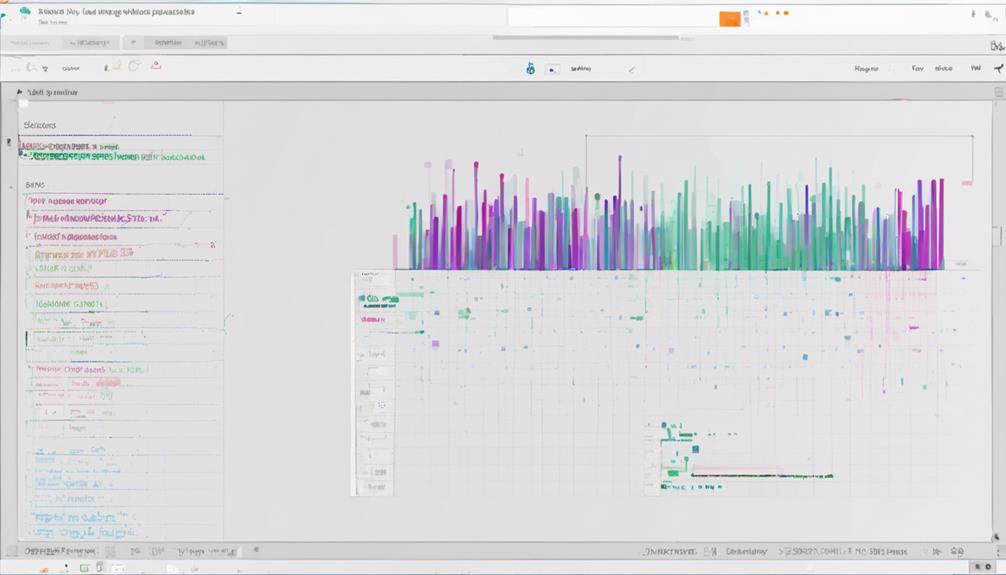With data scrubbing being hailed as the backbone of effective data management, you might be surprised to discover the 11 vital roles of data scrubbing in data management and how it ensures the integrity and reliability of your data assets. From enhancing data quality to enabling informed decision-making, each role contributes significantly to the overall success of your data management strategy. The impact of data scrubbing goes beyond just data cleanliness; it influences the very foundation on which your business operates.
Enhancing Data Quality
To enhance data quality, data scrubbing plays a crucial role in the realm of data management. Data standardization involves the process of structuring and formatting data in a consistent manner, making it easier to compare and analyze. By ensuring data normalization, which eliminates redundant data and inconsistencies, you can enhance the accuracy and reliability of your datasets. Data enrichment involves enhancing existing data by adding relevant information from external sources, further improving its quality and depth. Through data validation, you can verify the accuracy and integrity of your data, minimizing errors and ensuring its reliability for decision-making processes. By incorporating these practices into your data scrubbing efforts, you can significantly enhance the overall quality of your data, making it more valuable and trustworthy for various analytical purposes. Remember, the meticulous attention to detail in data scrubbing is essential for maintaining high-quality data standards in your organization.
Facilitating Data Integration
Data scrubbing plays a pivotal role in facilitating data integration within the realm of data management. By ensuring data standardization, which involves establishing consistent formats, naming conventions, and structures across different datasets, data scrubbing streamlines the integration process. This uniformity enables disparate data sources to be combined seamlessly, eliminating errors that may arise from inconsistencies.
Moreover, data normalization, another key aspect of data scrubbing, enhances data integration by organizing and structuring data to fit a specific model. Normalizing data reduces redundancy and dependency issues, making it easier to link related information accurately. This process simplifies data integration efforts by aligning data elements according to predefined rules, leading to a harmonized dataset that can be effectively integrated with other systems.
In essence, data scrubbing’s emphasis on data standardization and normalization significantly aids in the smooth and efficient integration of data, ensuring that disparate datasets can be combined accurately and effectively.
Ensuring Data Security
As data integration progresses, the focus shifts towards ensuring the security of the integrated datasets. Data security is paramount in data management to protect sensitive information from unauthorized access or breaches. One crucial aspect of securing integrated data is data encryption. By encrypting data, you encode it in such a way that only authorized users with the decryption key can access the information, adding a layer of protection against cyber threats.
Additionally, implementing robust access control measures is essential for data security. Access control ensures that only authorized individuals can view or manipulate specific datasets, reducing the risk of data leaks or unauthorized modifications. By setting up access controls based on user roles and permissions, organizations can restrict data access to those who require it for their roles, mitigating the chances of data misuse.
Safeguarding Data Privacy
When safeguarding data privacy, the focus lies on protecting individuals’ sensitive information from unauthorized disclosure or misuse. Data anonymization plays a crucial role in ensuring privacy protection by transforming personal data into a form that cannot be linked back to the individual. This process allows organizations to use data for analysis and research purposes without compromising individuals’ privacy.
Moreover, adhering to GDPR compliance is essential for effective data protection. The General Data Protection Regulation (GDPR) sets guidelines for how personal data should be handled, ensuring that individuals have control over their own information and that organizations implement appropriate measures to safeguard it. By following GDPR requirements, such as obtaining explicit consent for data processing and implementing robust security measures, organizations can enhance data privacy and build trust with their customers.
Upholding Data Governance
To effectively uphold data governance within an organization, it is imperative to establish clear policies and procedures that dictate how data is managed, accessed, and utilized. Data governance ensures that data is accurate, consistent, secure, and used in compliance with regulations. One key aspect of data governance is data cleansing, which involves identifying and correcting errors or inconsistencies in data to maintain its quality and reliability. By implementing data cleansing processes, organizations can enhance decision-making, improve operational efficiency, and mitigate risks associated with poor data quality.
Another essential component of data governance is data normalization, which standardizes data formats and structures across the organization. Data normalization streamlines data management processes, facilitates data integration, and enables accurate analysis and reporting. Through effective data normalization practices, organizations can eliminate redundancies, reduce data duplication, and ensure data consistency throughout the enterprise.
Improving Data Accuracy
Improving data accuracy is a crucial aspect of efficient data management within an organization. Data validation plays a key role in this process by ensuring that the data entered meets specified criteria and is accurate. By implementing data validation techniques, such as range checks or format checks, errors can be identified and corrected promptly, leading to a more reliable database.
Data cleansing is another essential step in enhancing data accuracy. This process involves identifying and correcting any inaccuracies or inconsistencies in the data. Through methods like removing duplicate entries, standardizing data formats, and updating outdated information, the overall quality of the data can be significantly improved.
Maintaining Data Consistency
When it comes to maintaining data consistency, your primary focus should be on ensuring data accuracy and enhancing data quality. By consistently verifying and validating data, you can prevent inconsistencies that could lead to errors in analysis and decision-making. This proactive approach plays a crucial role in maintaining the integrity and reliability of your data management processes.
Ensuring Data Accuracy
In the realm of data management, ensuring data accuracy, also known as maintaining data consistency, is a critical aspect that cannot be overlooked. Data validation and error detection play fundamental roles in this process. Data validation involves checking data for accuracy and completeness, ensuring it meets certain criteria or standards. By implementing validation rules and checks, you can detect inconsistencies or errors in the data before they impact critical decision-making processes. Error detection focuses on identifying and rectifying inaccuracies, duplications, or inconsistencies within the dataset. It involves using algorithms and software tools to scan through the data, flagging any anomalies that may compromise its integrity. When you prioritize data accuracy through validation and error detection techniques, you enhance the reliability of your database, leading to more informed analyses and strategic insights. Remember, accurate data is the foundation of effective decision-making and business success.
Enhancing Data Quality
To enhance data quality, maintaining data consistency is paramount. Consistent data ensures that information remains accurate and reliable across all systems and processes. One vital aspect of maintaining data consistency is through data validation. By implementing robust data validation processes, you can verify that the information entered into your systems meets specific criteria and standards. This helps in error detection by identifying and rectifying any inconsistencies or inaccuracies in the data.
Error detection is another key component of enhancing data quality through maintaining data consistency. By continuously monitoring data for errors or discrepancies, you can promptly address any issues that may arise. This proactive approach ensures that your data remains accurate and reliable, contributing to overall data quality.
Enhancing Data Usability
Data scrubbing plays a crucial role in enhancing data usability by ensuring the accuracy and consistency of the information stored in databases. When focusing on enhancing data usability, data scrubbing aids in:
- Standardizing Data Formats: By cleaning and standardizing data formats, data scrubbing ensures that all data entries are in a uniform structure, making it easier for users to access and analyze the information.
- Eliminating Duplicate Entries: Through the process of data cleansing, duplicate entries are identified and removed, reducing confusion and providing users with clean and reliable data for decision-making purposes.
- Enhancing Data Accessibility: Data scrubbing enhances data usability by organizing and structuring data in a way that improves accessibility. This makes it easier for users to retrieve the information they need quickly and efficiently.
Ensuring Data Reliability
To ensure data reliability, you must focus on data accuracy assurance through meticulous scrubbing processes. Employing error detection methods helps in identifying and rectifying inconsistencies promptly. Consistent data validation ensures that the information you rely on is trustworthy and error-free.
Data Accuracy Assurance
Ensuring the reliability of data is a critical aspect of data management. Data accuracy assurance plays a pivotal role in maintaining trustworthy information for decision-making and operational processes. To ensure the accuracy and reliability of your data, consider the following:
- Data Validation: Implement thorough data validation processes to verify that the information entered into your systems meets specific criteria and standards. This step helps prevent errors and inconsistencies in the data.
- Accuracy Verification: Regularly verify the accuracy of your data by cross-referencing it with reliable sources or conducting internal audits. This verification process helps identify any discrepancies or inaccuracies that may have arisen over time.
- Continuous Monitoring: Establish a system for continuous monitoring of data accuracy to promptly address any issues that may arise. Regularly reviewing and updating your data ensures its reliability and relevance for ongoing decision-making processes.
Error Detection Methods
Maintaining data accuracy involves more than just validation and verification processes; it requires robust error detection methods to ensure the reliability of your information. Error detection methods play a crucial role in identifying and rectifying inaccuracies within your datasets. By implementing effective error prevention techniques, you can significantly enhance the quality and integrity of your data. Utilizing advanced data validation strategies allows you to catch inconsistencies, anomalies, or discrepancies that could potentially compromise the reliability of your information. These methods help you spot errors such as missing values, duplicate entries, or incorrect formats, enabling you to address them promptly. By actively employing error detection mechanisms, you can proactively safeguard your data against inaccuracies and inconsistencies, ultimately ensuring that your data remains trustworthy and dependable for making informed decisions. Consistently monitoring and refining your error detection processes will lead to more reliable and robust data management practices.
Consistent Data Validation
Amidst the intricate landscape of data management, the cornerstone of ensuring data reliability lies in consistent data validation. When it comes to consistent data validation, there are key elements to consider:
- Data Integrity: Ensuring that the data remains accurate, reliable, and consistent throughout its lifecycle is crucial for maintaining data integrity. By implementing consistent data validation processes, you can prevent errors or discrepancies that may compromise the integrity of your data.
- Data Standardization: Establishing and enforcing data standards across your organization is essential for consistent data validation. By standardizing formats, structures, and definitions, you can ensure that data is uniform and easily comparable, leading to improved data quality and reliability.
- Automated Validation Tools: Leveraging automated validation tools can streamline the process of consistent data validation. These tools can help identify discrepancies, anomalies, or non-compliant data elements efficiently, allowing you to address issues promptly and maintain data reliability.
Achieving Regulatory Compliance
To achieve regulatory compliance in data management, a meticulous approach to data scrubbing is imperative. Compliance validation ensures that your data meets the necessary regulatory standards set forth by governing bodies. By implementing thorough data scrubbing processes, you can ensure that your data is accurate, up-to-date, and compliant with regulations.
Regulatory standards are constantly evolving, making it essential to regularly scrub your data to meet these changing requirements. Failure to comply with regulations can result in hefty fines, legal issues, and reputational damage. Data scrubbing plays a crucial role in identifying and rectifying any non-compliant data within your databases.
Enabling Business Intelligence
Enabling business intelligence through effective data scrubbing practices is essential for organizations seeking to derive valuable insights from their data. By ensuring clean and accurate data, organizations can improve decision-making processes and increase efficiency in various operations. Here are three key ways data scrubbing enables business intelligence:
- Enhancing Data Accuracy: Data scrubbing helps identify and rectify errors, duplicates, and inconsistencies in data sets, ensuring that the information used for analysis is reliable and precise.
- Facilitating Data Integration: By standardizing data formats and eliminating discrepancies, data scrubbing enables seamless integration of multiple data sources, providing a holistic view of the organization’s information landscape.
- Empowering Predictive Analytics: Clean data sets obtained through data scrubbing lay a solid foundation for predictive analytics models, allowing organizations to make informed forecasts and strategic decisions based on accurate insights.
Frequently Asked Questions
How Does Data Scrubbing Impact Data Storage Efficiency?
Data scrubbing significantly impacts data storage efficiency. It helps improve accuracy by removing inconsistencies and errors, resulting in a more streamlined database. This process enhances performance as it ensures that data is clean and optimized for faster retrieval.
Can Data Scrubbing Help Detect and Prevent Insider Threats?
Wondering how data scrubbing can keep your data safe? Yes, it helps detect and prevent insider threats. By using data scrubbing for compliance monitoring and fraud detection, you can safeguard against internal risks effectively.
What Are the Challenges of Implementing Data Scrubbing Tools?
Implementing data scrubbing tools presents challenges such as cost implications, staff training, and data accuracy concerns. Overcoming implementation hurdles requires strategic planning, ensuring proper training for staff, and maintaining data integrity throughout the process.
Does Data Scrubbing Reduce the Risk of Data Breaches?
Data scrubbing plays a crucial role in enhancing data privacy and bolstering cybersecurity measures. By systematically identifying and rectifying errors or inconsistencies in data, it reduces the risk of data breaches, ensuring a more secure environment.
How Does Data Scrubbing Support Data Analytics Initiatives?
Data scrubbing significantly enhances data quality and accuracy for analytics. By removing inconsistencies and errors, it ensures reliable insights. An astounding 80% of data analysts credit data scrubbing for improving the effectiveness of their analytics initiatives.



